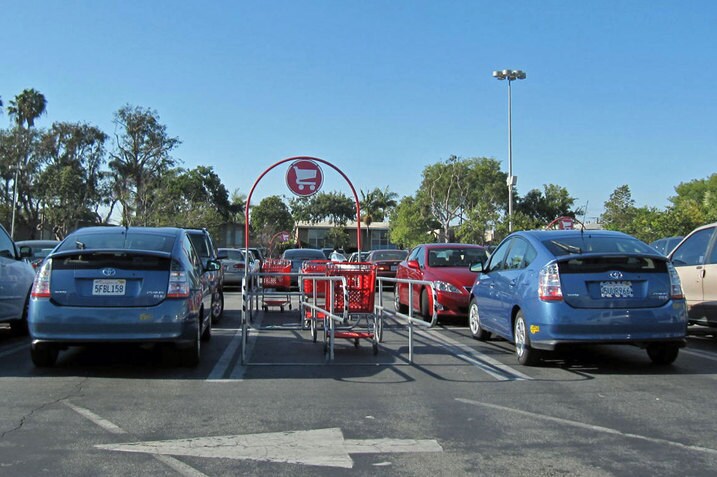2004 Toyota Prius: What's It Like to Live With?
Read the latest updates in our long-term road test of the 2004 Toyota Prius as our editors live with this car for a year.
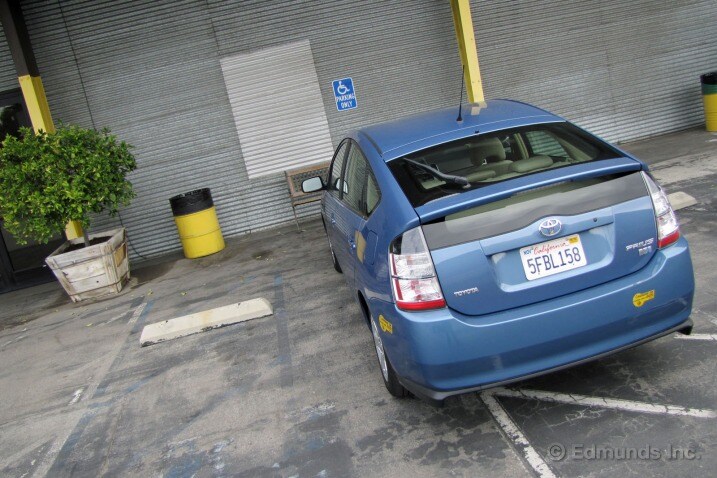
What do you want to know about?
- Introduction
- Recall
- Temperamental Fuel Gauge
- Superman of Automobiles?
- Malfunctioning Nav or Calling Inspector Gadget?
- Silent Prius, Broken Prius
- Another Plus
- No Warranty, No Love
- Prius Fuel Gauge Issue
- Running to Empty...Eventually
- Gauges Fuel Correctly
- Still Going Strong After 47K
- Welcomes Race Fans
- Approaching 50,000 miles
- Easy Shifter
- Rest in Peace?
- What It's All About in California
- Play That Funky Old School Music, Hybrid
- Educational Road Trip
- Maintenance?
- DIY Oil & Filter Change
- Twins!
- Oh yeah, it's a Hatchback too
- Hooray for the Tape Deck
- Unintended Rattleation
- Unintended Rattleation Fixed!
- Storage Galore
- Stop Beeping!!!
- Day 22 on the DL
- Happy 70K!
- How Long Should a Seat Last?
- Full-Fledged Freak Out
- Freak Out Fixed
- Higher Age, Lower Fuel Economy
- Do Missing Parts Make it Look Better?
- Soap and Water
- Our Favorite Caption
- You Write the Caption
- ESC Freak Out!
- Speed Oil Change
- New Tires Cured Our ESC Problem
- Hot, Hot, Heat
- Open Thread
- Valet Instructions Card
- Fuel Economy History
- Too Easy To Tame
- Jumpstarting a Hybrid
- The Bar Graph, Old vs. New
- Thanks For The Shopping Cart, Jerkface
- "B" Is For Bad
- History and Future
- A Little Old School, a Little New
- Big Digital Speedo
- Deal Breaker No More
- First Brake Job at 86K Miles
- Why I Bought it
- Imagine It Bigger
- Life after the Long Term Fleet
- It's Been a Good Run
- Wrap-Up
Introduction
Four years ago we purchased a Honda Insight and reported on the ownership experience as part of our Edmunds.com long-term test fleet. Since that time the Insight has been joined on the market by the Civic Hybrid and the Toyota Prius. While the Insight was the first hybrid to be sold in this country (and the winner of our Most Significant Vehicle award that year), the Prius was actually the first production hybrid vehicle to be sold to consumers...in Japan.
That Japanese Prius eventually made it into U.S. showrooms in 2001, but the car's diminutive size, quirky controls and "Echo-like" styling limited its appeal to mainstream consumers. Now comes the 2004 Prius, an all-new, more powerful and larger hybrid sedan that offers almost Camry-like seating space and a hatchback design for improved cargo hauling. It also burns cleaner than the original Prius, earning both SULEV (Super Ultra Low Emissions Vehicle) and PZEV (Partial Zero Emissions Vehicle) ratings. Fuel mileage is impressive, with EPA ratings of 60 mpg in the city and 51 mpg on the highway. Yes, those numbers are correct — the Prius actually gets better mileage in city driving because the electric motor can often propel the vehicle at low speeds with no assistance from the internal combustion engine, meaning it uses no fuel whatsoever under these conditions. The Hybrid Synergy Drive power plant consists of a 1.5-liter, four-cylinder gasoline engine and a single electric drive motor. The gas engine produces 76 horsepower and 82 pound-feet of torque, while the electric motor generates the equivalent of 67 hp and 295 lb-ft of torque. An electronically controlled continuously variable transmission (CVT) is standard on all models.
Demand for the all-new Prius has surpassed everyone's expectations, including Toyota's. The vehicle is currently one of the "fastest selling cars" in America based on how long the average model sits on dealer lots before being sold. In Southern California, waiting lists for a Prius are common, as is dealer markup. Many dealers have given current Prius owners the first opportunity to buy the all-new version, but without that factor on our side, we simply had to start calling around with the hopes of finding a dealer willing to work with us on acquiring a car.
About four months before the Prius was due to hit dealership floors, Consumer Advice Editor Philip Reed began contacting Toyota dealerships in the Los Angeles area. He told them that Edmunds.com wanted to get the new Prius as soon as possible. He was also upfront about the fact that we were on multiple waiting lists for the car. As far as specifications went, Phil told dealers that we were flexible on options and on color. We also asked for the sale price, and if the dealership was asking for a markup on the vehicle, we declined to buy our Prius there.
Eventually, we wound up on three different dealership lists. Dianne Whitmire, Internet sales director for Carson Toyota, was the first to call. She told us about a lightly optioned Driftwood P, and we passed up this car since we weren't enthusiastic about the color and had decided to go for more options. Dianne was undeterred. She called us about two weeks later with a fully loaded Prius in Seaside Pearl Blue with an Ivory interior. We jumped at the chance to buy this car. The Prius landed on the lot just about when she predicted and we were there with a check in hand. We paid $26,053 for our Prius (including destination) which featured Package #9 (which includes items like a DVD navigation system, in-dash CD changer and HID headlights), floor mats, the rear bumper appliqué and a cargo net.
Interestingly, our Prius was one of about five to arrive at Carson Toyota at the same time. When we got to the dealership, they were lined up and ready to be delivered to their new owners. As we waited, excited buyers showed up with money in hand. As we left the dealership, barely an hour later, all the cars were gone. For once, the car salesman's sales pitch "you better buy today 'cuz these cars are flying off the lot" was entirely accurate.
With the loaded Seaside Pearl Prius in our possession, we were anxious to try out the hybrid drivetrain in terms of both power and fuel mileage. In fact, with just over 1,000 miles on the odomoter, we ran the vehicle through our standard battery of performance tests and recorded a 10.7-second 0-to-60 time and a 17.7-second quarter-mile time at 77 mph. Not exactly hot-rod figures, but when you combine those with the 40.4-mpg average we've scored in our first 4,500 miles of driving the car, it becomes clear that the Prius offers a compelling combination of performance and fuel economy.
Editor in Chief Karl Brauer drove the Prius for much of those first 4,500 miles and had this to say about the powertrain:
"While not fast, the Prius doesn't feel at all slow, and it can actually surprise you when you go from casual cruising mode to full-throttle application, such as when passing another car. The electric motor adds a noticeable punch when you floor it --- assuming the battery isn't so drained that the car is in constant charge mode." Yes, like the Honda Insight before it, the electric motor can supplement the internal combustion engine for increased performance, but only if the battery pack has sufficient power. However, unlike the Insight, it was rare that the Prius' battery pack fell below half charge, meaning the electric motor was almost always ready to help out with acceleration chores.
As helpful as the electric motor is when needing maximum acceleration, Karl really enjoyed trying to make the Prius run on pure electric power during low-speed city driving. "It's not easy to keep the Prius in 'electric-only' mode," Karl said. "If you ask for more than modest acceleration, the engine fires up and kicks in to offer more boost. But if you accelerate very slowly you can go from zero to about 30 mph on pure electricity...as long as you aren't going up a hill."
Of course the Prius offers an effective method for monitoring energy/fuel consumption. The central monitor can be set up to tell you when the engine, electric motor or both are operating. It can also tell you instant fuel mileage, average fuel mileage and fuel mileage over multiple blocks of five-minute periods. As Karl opined, "All of this information takes some getting used to, but once you figure it out, you can get a feel for how subtle changes in driving behavior can cause vast changes in fuel mileage."
Speaking of mileage, Karl observed that while the potential for mile-per-gallon figures in the upper 50s, and beyond, exists when driving the Prius, he also noted how hard it can be to attain those figures unless driving conditions are ideal. "I drove the car from Los Angeles to Las Vegas and back, and I was surprised at how quickly the car's fuel mileage would drop when driving up a hill or into a head wind. It was also pretty skittish in strong crosswinds, no doubt because of the car's fuel-mileage-oriented low curb weight and skinny tires."
Although Karl was somewhat disappointed in the Prius' initial fuel figures, he remarks that the car is still not broken in, and that he often drove it in anything but a reserved, fuel-efficient manner. During those times that he made a conscious effort to go light on the throttle and drive in a relaxed manner, he saw an immediate jump in fuel mileage. "Had I driven that way for an entire tank of fuel I'm sure it could have averaged around 50 mpg, which is pretty much what the car should be getting on the highway." Karl also noted that driving in a reserved manner for a tankful of gas is difficult, because when you drive that way a tankful of gas can last over 500 miles!
Other than the somewhat disappointing fuel mileage, Karl had few complaints. "I have to have the seat all the way back, and even then I barely fit comfortably in terms of legroom. I also noticed that the central display screen can wash out in bright sunlight, and it doesn't have a tilting feature, like Toyota's own Sienna, to help combat this problem."
On the positive side, Karl described the Prius' seats as comfortable, the front cupholders as fully functional and the cargo capacity as superb, particularly when folding the rear seat back down. He also liked the many features on our test car, including the DVD-based navigation system, the HID headlights and the voice-operated audio system. "However," Karl noted, "I still wish Toyota would allow passengers to interact with the navigation system while the vehicle is in motion, as Honda does."
With a year ahead of us, we're hoping to see the Prius' fuel figures climb. But even if they remain in the 40s, we are already impressed with the car's functionality, comfort, luxury features and style. We'll see if our love for the Prius can survive a year with the Edmunds.com staff.
Current Odometer: 4,887
Best Fuel Economy: 48.6 mpg
Worst Fuel Economy: 28.1 mpg
Average Fuel Economy (over the life of the vehicle): 40.4 mpg
Body Repair Costs: None
Maintenance Costs: None
Problems: None
Recall
In light of the recent announcement by Toyota of a steering malfunction in some Prius models built between '02-'05, we thought it a good idea to see if our long-term car was part of the recall.
One member of our staff happens to have a personal friend that works in Toyota customer service, so a quick phone call confirmed that our VIN was not on "the list" for this current campaign. Our recommendation to other Prius owners is to contact your local Toyota dealership and find out if this steering concern applies to your vehicle.
Temperamental Fuel Gauge
Having recently turned 44,000 miles on our Prius we were not surprised when the maintenance light came on. The day it was scheduled for service at Toyota of Santa Monica we noticed a problem. The fuel gauge read (an optimistic) half-full but the car wouldn't take any gasoline.
We tried to fill it at one pump to no avail, so we pulled to the neighboring pump with similar results... Driving to another gas station altogether we tried once more but were still met with a familiar click-click-click from the pump. Nothing. We asked the dealer to look into this issue during service.
The car spent the night with the Toyota folks in order to address the accuracy of the fuel gauge. When we picked it up the next morning we paid our $195.01 bill for the service and learned that they were unable to recreate the fuel problem. All systems checked out OK.
This same situation arose at 24,000 miles at which time the dealer performed a computer re-flash (per an outstanding TSB on the fuel gauge) to remedy the inaccuracy. Our advisor suggested we keep an eye on it and return to the dealership if the problem resurfaces. The next fill-up should tell the tale: was it a fluke, or do we have a real problem on our hands?
Superman of Automobiles?
When the curiously shaped Mr. Prius first arrived people asked, "What are you? A bird? A plane?" Mr. P replied in a strange, humming voice," I am a hybrid, and I'm here to save the earth." The questions continued, "How do you drive? Are you faster than a speeding bullet?" With a chuckle Mr. P clarified, "No, no, no, I only look like a bullet."
Prior to this weekend I had not spent much time in our long-term Prius (nor had a seen the 'History of Superman' special on A&E). After 4 days behind the wheel trying to diagnose a potential fuel gauge problem, I realized a couple of things about this car first-hand:
I was under the misconception that the Prius, with its free-pass to the carpool lane (above), guaranteed speedy travel for my daily Long Beach to Santa Monica commute along the 405 freeway. Wrong. While it helps quite a bit outside the rush hours, the always-congested Thursday drive proved to be its kryptonite - - not even mighty Mr. Prius could resist its energy-sucking powers. What a hair-pulling turn of fate to be trapped at a standstill behind the double-yellow lines of the carpool lane as everyone else drove right past me.
Another observation: The NAV system is straightforward and easy to use but the screen does not fare well when the sun is up. Minimal sunlight produces a glare that renders the display completely useless and there does not seem to be a fix outside of holding a hand over it to shield the light.
Following a couple of fill-ups and several hundred miles we're yet to experience the same fuel read-out issue, which is good news. During the last 400 miles my fuel mileage was an eco-friendly 49.3 mpg in mostly city driving. We'll continue to pay close attention to the fuel situation but as of now it appears we're all systems go.
Malfunctioning Nav or Calling Inspector Gadget?
During my commute home last night, the Prius's nav started going haywire. Unfortunately, a lot of the car's systems are operated out of this computer, like the audio and climate controls. I couldn't access the map and sometimes I would get overlapping display screens.
I was listening to the radio but the car's computer kept telling me the audio system was off... While I could control the volume and change the stations from outside the computer, I couldn't tell what radio station was set. Then the audio started blanking out and back on every few seconds. I ended up stopped at a red light under an overpass and lost power to the radio completely. It was a particularly bad song so I didn't care much. But I hit the power button anyway and the radio came back on and the nav system started working properly. I had been stuck in traffic and was suddenly surprised by how much I had depleted the battery. I had been getting an improper reading while the system was freaking out.
I was in and out of the Prius several times that night, and each time the computer would go crazy again.
Because the Prius is normally so reliable and no other editors have complained about this, I suspect the problem may have been caused by my fancy new cell phone. When I first got the phone, my wireless internet connection at home crapped out. When I called the wireless company, they asked if I had a new gadgety phone. Sure enough, the phone was the culprit. My wireless internet company changed my service to a different channel and now my mobile phone and wireless service are cohabitating nicely. At the time, my phone wasn't even turned on. Its mere presence in the house was enough to cause interference.
So, I am passing the Toyota Prius along to another editor. We'll see if our trusty little hybrid goes back to its normal reliable self.
Silent Prius, Broken Prius
The weekend after Thanksgiving is usually the weekend during which radio stations begin playing Christmas carols. But there were no carols to be heard over the last few days, at least not within the cabin of the Toyota Prius.
Our Managing Editor Donna DeRosa had reported earlier that she'd experienced problems with the car's navigation and audio systems; she'd thought that maybe the issue was somehow linked to her new high-tech cell phone. During my time in the Prius, I experienced problems as well, with nary a fancy-schmancy cell phone in sight... The radio would intermittently cut out, making it impossible for me to tune in to the joyous music of the holiday season. That I didn't miss so much, but it would have been nice to get some KCRW every now and then.
Our Prius has been rock-solid in terms of reliability over the past couple of years, so this glitch is very much out of character. We've scheduled a visit to the dealer to investigate the problem.
Another Plus
With its snub-nose, hatchback styling, the Prius offers more than a roomy, extremely space-efficient cabin, it also makes for easy parking. While parallel parking, its a snap to back the Prius into place thanks to the additional glass window on the hatchback that allows you to easily judge how close you're getting to the car behind. That handy window isn't an innovation, however (remember the Honda CRX?). And the Prius' Pug-like nose allows you to usually back in and pull out in one shot, whereas a vehicle with more hood typically requires a couple of back-and-forth jockeying moves before it's clear of the car in front.
In other news, the climate/audio interface (aka the nav. screen) is still on the fritz. During this past weekend in the Prius, sometimes it worked, sometimes it didn't. We're still waiting for the part to come in at Santa Monica Toyota which should be sometime this week.
No Warranty, No Love
We're approaching 46k miles in our '04 Prius, which means the warranty umbrella is becoming smaller and smaller. Its small enough now that it no longer covers our recent electrical rebellion from the NAV/radio screen.
It took the dealer a few hours to diagnose the malfunction as an electrical short and recommend replacing the entire display screen. As one might expect, this lightens the wallet substantially: $96.88 for labor, $460 for parts, 1 arm and 1 leg... A total of $604.83 after taxes.
Our service advisor blamed it on the sun. In the past we've experienced a glare across the NAV screen during daylight driving, so this explanation seemed to make sense. That was until our inner skeptic saw a display at the cashier's counter advertising nothing other than covers for Prius display screens - - now available in the parts department. Coincidence? Conspiracy aside, it just might be worth the $39.99 investment.
Prius Fuel Gauge Issue
The last two times we topped off the Toyota Prius' fuel tank the gauge hasn't shown more than three-quarters full, so yesterday I took the Prius to the Toyota dealer when I picked up the RAV4.
The service writer said they'd recalibrate the gauge and we'd see what happened then. I went to pick it up today, and still, the gauge only shows three-quarters, even after I added 2.8 gallons of gas after leaving the dealership.
After flipping through the fuel log, I realized we haven't let the tank drain since early November, instead we've been topping off a couple of gallons here and there... After talking to the dealer again, we've decided to run it down to empty before we refuel to see if the gauge will read accurately after that exercise.
Running to Empty...Eventually
This weekend I was tasked with running the Prius til it was bone dry, but found it was a lot harder than I thought considering I wasn't going anywhere too far, just in and around town. The request to pack miles on the Prius was due to its odd inability to be sated — the fuel gauge always displays that it's 3/4 full. So I drove to and from Long Beach, always took the long leisurely way round on my errands and floored it whenever the opportunity presented itself. What did I get for my efforts?.. 113.4 miles added to the odo and one bar taken off the fuel gauge. Woo. Being wasteful is hard work in the Prius, especially since it's not really a fun car to drive in the first place. If it were, the miles would be easier to accumulate and not the chore it was for the sake of this little experiment.
I know, fun is not the point of the Prius, but damn. However, for those who are practical and who just want something economical to get around town, it's perfect for ya. It's quiet, comfortable and in some cities you actually get free metered parking.
Gauges Fuel Correctly
We've been working our way through a full tank of gas in the Toyota Prius since the fuel gauge was recalibrated last week. The dealer told us the only way to verify that the gauge was now working correctly was to drain it and fill up.
After driving it down to one bar on the gauge, we added 6.271 gallons to the tank and ta-da, the gauge illuminated all the way to full.
Problem solved...
Still Going Strong After 47K
I took a quick spin in our eldest long-termer, a 2004 Toyota Prius, which is now at 47,470 miles. I still think it makes a very practical city car, although I'd be unlikely to buy one as my only car because of its near total disregard for driver enjoyment. That said, our long-termer is holding up quite well. It's rattle-free and the only terminal wear is the threadbare armrest on the driver door.
Another thing that struck is me is how modern the car still feels on the inside. Four years into the model cycle, a lot of cars already feel dated, but the Prius' cabin electronics are still as high-quality and user-friendly as any you'll find in '07 model year cars. I particularly like the audio system interface.
If pressed, though, I'd say that while I generally like the car's touchscreen interface, I'd wish Toyota allowed you to manage the basic climate control functions ("auto," "off" and temperature up/down) without using the screen.
Another element of the Prius that still seems cutting-edge: its dash-mounted shifter. Several luxury manufacturers now have their own easy-effort column shifters, but the one in the Prius remains one of the easiest to use.
Finally, there's storage. With each passing year, we expect more in the way of creatively designed storage slots, and with its extra-long center console unit, the Prius still offers more functionality than most of the midsize sedans in its price range.
Welcomes Race Fans
It's not often the Prius has an opportunity to run a race track. But as a Long Beach resident, I couldn't resist giving the Toyota hybrid a chance to take on a section of the 2.02-mile Long Beach Grand Prix course on my way home this week.
Construction has been underway since early February or so, and race weekend officially starts tomorrow.
The mighty Prius and I were running the course in reverse, so the view through the windshield is around the bend in the front straight along Shoreline Drive, near the pits and the start/finish line...
At 32 mph, the Prius was in its sweet spot.
Approaching 50,000 miles
We are ahead of the curve with the regular service on our long-term Prius. Just as the odometer turned 49,055 miles the maintenance light told us it was time to see the dealer for its 50k-mile service.
It turns out this is one of the minor intervals on the schedule. It consists of routine visual safety inspections, engine oil and filter change and a tire rotation... Our appointment at Toyota of Santa Monica was quick and cost us $92.36 when all was said and done. That is right on par with the price we found on Edmunds Maintenance Guide.
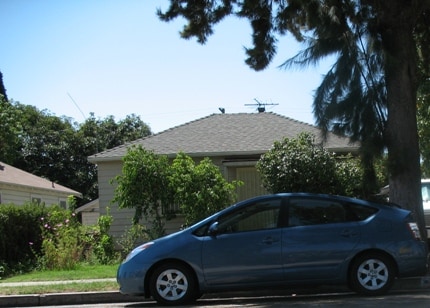
An older friend of a friend is in the market for a car. She's got arthritis in her hands, and wants a car that won't be too manually demanding. I recommended the Toyota Prius. Here's why:

It's all about the Prius's dash-mounted shifter... Of course, other cars offer column shifters, but few are as easy to use as the nifty little nub you'll find in the Prius. There's nothing to grip, no buttons to press. A gentle nudge is all it takes to get you from "park" to "drive."
Our 2004 Toyota Prius is no high priest of performance, but I still enjoy my time spent with it, because of little touches like this.
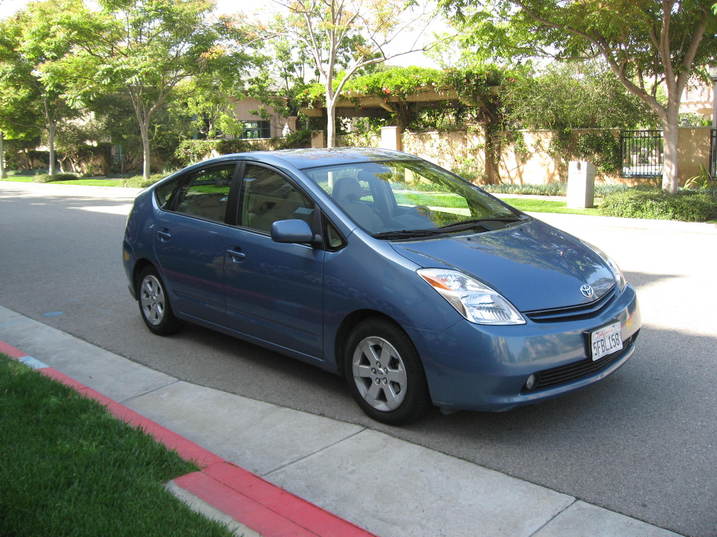
There were reports previously that stated that the Gen2 Toyota Prius (our long-term 2004 Prius is a member of this generation) would continue on, even when the 2010MY Gen3 was launched.
It didn't happen. Sales of the Gen2 were discontinued in the U.S. There were reports that Gen2 would continue in Japan only, but I checked the Toyota Japan website (wonderfully translated to English by "Don't Be Evil" Google), and couldn't find the Gen2 anywhere.
That's fine with me. While our long-term Gen2 is a fine commuter car (only), the Gen3 would be an acceptable road trip car. With the Gen2 you have to put up with the CVT drone/groan, the somewhat harsh ride, and the susceptibility to crosswinds. All of that has been addressed by Gen3.
Gen2 Prius: RIP.


This is what really matters on our 2004 Toyota Prius. These stickers are worth the car's weight in gold. They allow you access to the
high-speed
carpool lanes.
If you were in the market for a pre-owned Prius, how much more would you be willing to pay for the stickers?

A month or so ago, I mentioned that our Prius felt a little old school because it didn't have a rear backup camera. Well, I still feel that way, but there is something else that really drives the point home.
Yes, our Prius has a tape deck. A full logic control tape deck at that. You probably don't even know what that means do you? Well, I remember, sort of, but I don't usually give that information out freely.
It does bring up another question though. How soon before cars don't even have CD players? Seems like every new car has an auxiliary jack at the very least, if not a dedicated iPod connection of USB port.
I bet most interior designers would be glad to get rid of that big, wide slot that takes up so much dashboard real estate. What do you think? 5 years, 10 years?

My fourth grader is working on a school report about the California Poppy Reserve (our state flower, ya know) and I decided the 100-mile run between our home in Long Beach and the reserve in the Antelope Valley was too short not to give her some firsthand knowledge.
So Saturday morning we drove the long-term 2004 Toyota Prius from the beach through the Santa Monica mountains, into the San Fernando Valley, passed by a Los Angeles aqueduct, rolled along Vasquez Rocks Natural Area Park and Red Rock Canyon State Park (Flintstones movie was filmed in one of those areas, Emma asks, "What do rocks have to do with vitamins?!") into the high Mojave Desert.
After exiting the 14 freeway in Lancaster on Ave I, we passed by a juvenile detention center, a state prison and a humane society before we arrived in the land of orange flowers.
The Prius chugged along through it all, struggling loudly up the sizeable grades, appreciating the downhill miles.
Next school project this month is about the San Miguel Mission, which Google maps tells me is 235 miles or a mere 4-5 hours each way.
Might need to pick a more ambitious car for that one.


And just like that, our 2004 Toyota Prius' maintenance indicator illuminated at the exact mileage noted on the window sticker the dealer's service department had carefully placed on the inside of the windshield.
Is that a dealer or manufacturer recommended interval? I know the 2005 Prius has a 7,500-mile oil change. Our 2004 Prius chimed at 5,000 miles.
I'd better find out.
The "Maint Reqd" light came on in our 2004 Toyota Prius a few days ago. Turns out the only Maint that light Reqds is an oil change.
It's a sunny day and I need some driveway time. Let's do this. And we'll turn off that poorly abbreviated light while we're at it, too. [Why couldn't the light simply say "Oil Change"? No guesswork reqd.]
And check out the weird noises the Prius makes while it sits parked. This car may help me realize my dream of becoming a Foley artist.

With so much emphasis put on the Prius's fuel economy and whether or not it drives like a "real car," we sometimes forget that it's also a useful hatchback. A file cabinet fit snugly and did so without folding the rear seat backs (or removing the luggage cover thingy). Safer that way.

Yeah, I don't want to read about an old Prius either, but hear me out. This thing was redistributed within the company and therefore out of the LT fleet so long, its return means we've basically added another used LT car, like the Z06 or M3 (well, sorta). So as such, here's some used car advice.
As Kelly noted earlier this month, the Prius has a tape deck. While you can make all the books on tape jokes you like, you'd better hope that your used car from let's say 2006 and earlier has one. Because if it doesn't, it likely only has a CD player, which means you can only play an iPod through one of the those horribly unreliable FM modulators. You can also buy an aftermarket unit, but you know, that costs money.
Since the Prius has a tape deck, I'm able to enjoy my iPod as well as my portable satellite radio. The same goes for my '98 Z3, the '02 M3 and our old diesel Jetta. Other than the M3, I've found sound quality to be pretty decent.
The Z06? No dice, only a CD player. You can't fault GM for that, but in 20-20 hindsight, it would've been nice if it hadn't been so hip in 2002 and ditched those fussy old tape decks.

The elderly Prius is emanating a horrible, hollow, plastic-on-plastic rattle over broken pavement. I'm sick of it; it's driving me nuts. Luckily, I've been able to figure out it's coming from the dashtop center-channel speaker. As such, I'm going to fix it. More on that tomorrow.
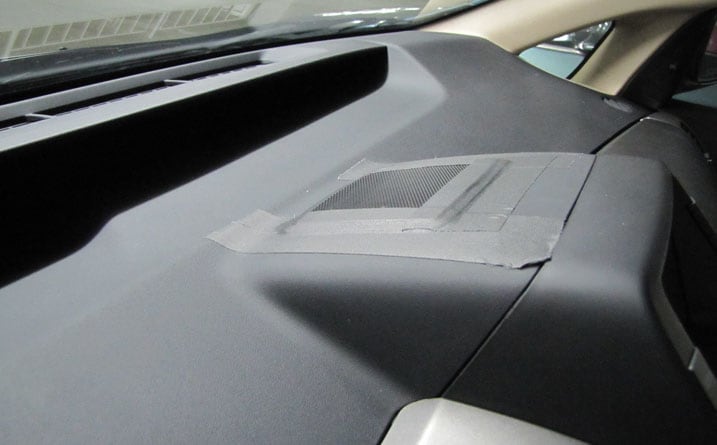
What, did you expect me to rip the dash apart and fit some sort of apoxy to the grand widget of the speaker's watchamadoo? Um, no. I went down to the video/photo department, grabbed some tasteful black gaffer's tape and went at it. I could trim the nearest corner a bit, but given that the speaker points away from the driver toward the windshield (how is that good for sound quality I wonder?) you can't really see my handywork. Perhaps we'll get it fixed for real someday ... say in 2016 when we finally get around to selling the Prius.
Anyway, as the video shows and my drive home proved, I indeed fixed the problem. As such, I rule! Now, I wonder if gaffer tape will work on those pesky electrical gremlins that haven't been causing me to crash?
The Before Video Below

The second-generation Prius has some of the most plentiful and useful storage areas of any car. The center armrest bin is absolutely enormous, the cupholders are generously sized and fold away nicely, and that hidden center compartment is perfect for an iPod (and a left-over taco as I discovered last night). You also get that split-level glovebox, in addition to a pretty useful hatchback trunk.

The new car is perhaps more stylish and its controls not reliant on the touchscreen (and hence easier to use), but some of that storage has been lost. One of the cupholders is now under the center armrest and note how the space between the seats is now covered by the jutting-out center console, therefore making it less useful for storing a purse. No, I don't have a purse (not counting my briefcase), but that open space is one reason why my mother has enjoyed her two CR-V's so much.
As such, I'd say the old Prius' emphasis on function over form was the way to go.
Beeping, plus commentary/enraged ranting. Why did someone think the Prius was the only car that needed this?
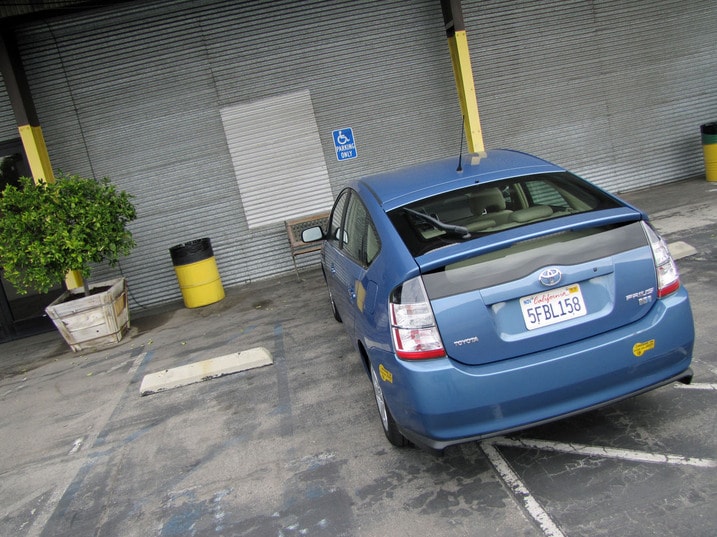
A little less than a month ago, I ran a baserunner down in a rundown, dove to tag him out, made the play, then landed on my outstretched shoulder. In the process I dislocated my shoulder and broke my humerus bone in three places. Oh, I also sprained my right wrist. It was unpleasant.
Since then, I've been living in a handsome 2010 Donjoy Arm Sling, which I've been told is the Cadillac of arm slings. This made a manual transmission out of the question, and my sprained wrist made low-effort steering a nicety. After a few days in the Insight, I was transferred into ye olde Prius where I stayed until today. I'm finally out of the sling and on the road to recovery. Hmm, I wonder if there's actually a Recovery, Ohio, or something out there. That would be fun.
Where was I? Oh yeah, 18 days in a Prius, which makes it the longest I've spent in a single car in more than three years since before I worked at Edmunds and drove an Acura TSX. And to tell you a secret, I don't mind the Prius.
I've actually never minded the Prius. Oh, I find many of its drivers infuriating, but as a practical form of transportation, it's a brilliant little car. The back seat is enormous, the trunk is useful, storage is plentiful, equipment is generous, noise is kept decently in check, the stereo is strong and the ride is comfortable. Oh, and I also managed 41 mpg making absolutely no effort to putter about like a half-dead hybrid driver.
I especially like that the Prius has gobs of character thanks to its many quirks. The weird shifter, the weird dash layout, the weird 1991 Pontiac steering wheel buttons aplenty, the weird digital gauges and heck, even the hybrid system is pretty darn weird. There's no other car like this second-gen Prius — even the current-gen car — and I like that.
Sure its boring to drive, sure its drivers move at the speed of continental drift and sure its driving position is intended for the average Japanese female, but I strangely like the Prius. But am I glad to be finally out of it? Oh yes indeed.
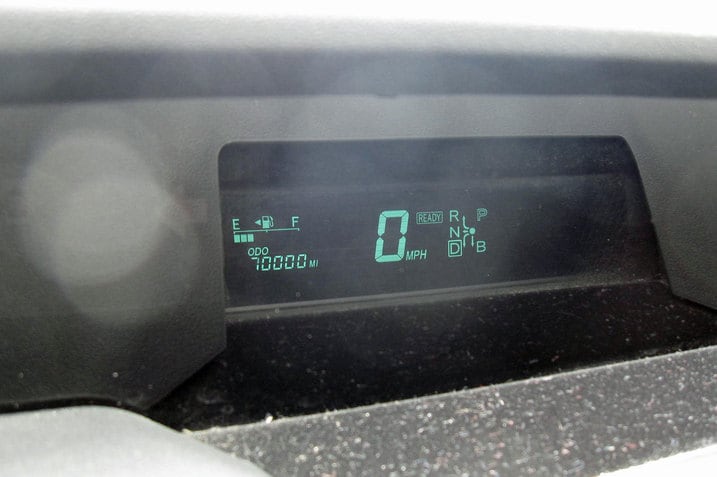
Yesterday, our Toyota Prius crossed the 70,000-mile mark, a record I'm sure for a long-term test vehicle.
Yes, yes, I know, hardly an accomplishment considering its a 2004 Prius. If it wasn't stuck on local city duty for much of its time, the mileage would certainly be higher.
Either way, here's to you, Prius and your quiet 70K!

I've been driving our long-term Toyota Prius quite a bit lately, and I can't shake the feeling that the driver's seat isn't as comfortable as it used to be. I start getting fidgety after 30 minutes or so, and get out after an hour with a stiff lower back.
From the photo alone, you can tell the Prius' interior has taken somewhat of a beating, but is the seat cushion really wearing down after 70,000 miles, or am I just getting old?
Wait, don't answer that.

This array of dash lights appeared on our Prius yesterday while driving on the freeway. No obvious trigger incident occurred.
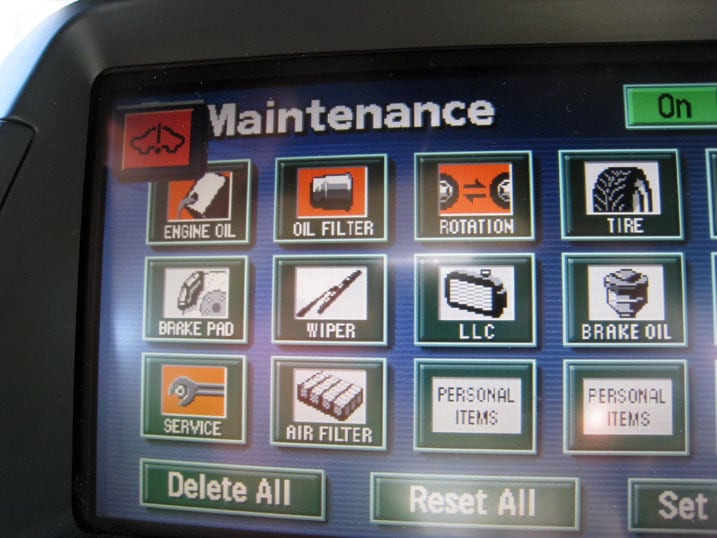
This warning light and various service indicators also appeared on the multi-information display. Clearly, we're due for some regular maintenance.
Toyota of Santa Monica is working on a diagnosis. We'll let you know more when we know more.
This is a test:

A few days ago, our 2004 Toyota Prius officially freaked out and was left at Toyota of Santa Monica.
Well, now it's back, the lights are off, the car has a new inverter pump (thing that pumps coolant to the electrical system) and a new A/C compressor (thing that pumps coolant to the interior occupants). And we're out a whole bunch of money. How much? Follow the jump.
::drumroll::
Did we mention it was out of service for only two days?
Or that they called us frequently with updates?
Or that it came back washed?
Or that they've got really good, fresh doughnuts in the morning?
Ok, ok. Sorry.
Inverter pump:
Labor: $533.50
Parts: $147.63
A/C Compressor:
Labor: $469.36
Parts: $1,240.07
Total labor: $1,002.86
Total Parts: $1,387.43
Tax: $135.27
Grand total: $2,525.56
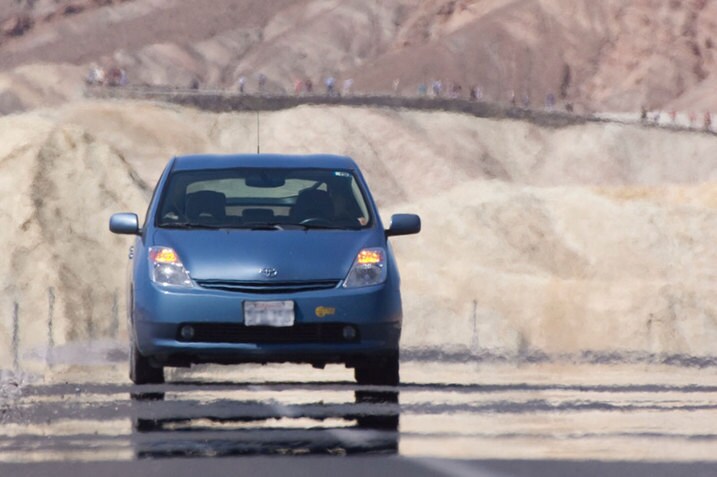
Yep, we still have a 2004 Toyota Prius in our long-term fleet. It may not have as many miles as some out there, but we recently broke the 80,000-mile mark. We used this as an excuse to compare the first 10k of Prius fuel efficiency to the last 10k.
1-10,000 miles
min: 28.1
max: 57.6
avg: 41.9
74,000-84,000 miles
min: 18.5
max: 50.8
avg: 37.3
Our lifetime average in the Prius is still 40.4 mpg. But after roughly 5 years of ownership our average fuel economy is down about 5 mpg (for reference, our 65k-Flex shows no mpg degredation between similar intervals). Imagine this is your Prius. Would this trend concern you?
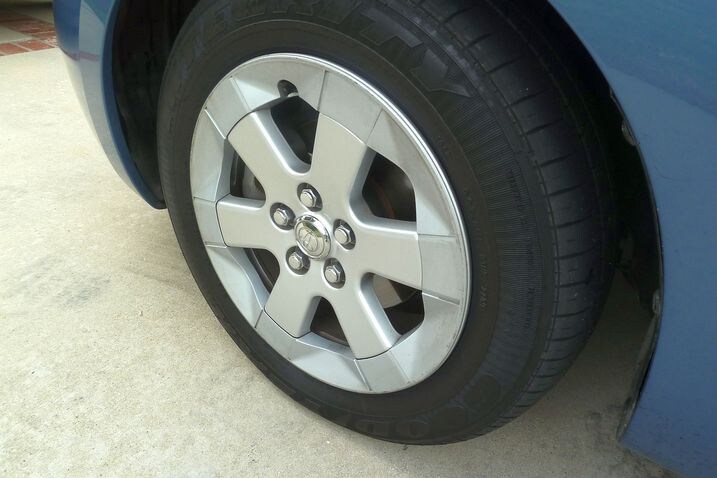
A part fell off our 2004 Toyota Prius, and now it looks better. Like everything else on this car, the wheels are a bit odd.
Toyota started out strong with relatively lightweight 6-spoke alloy wheels, but then mucked them up with some painted plastic trim rings. Who the heck puts plastic trim rings on an alloy?!
One of them recently went missing.
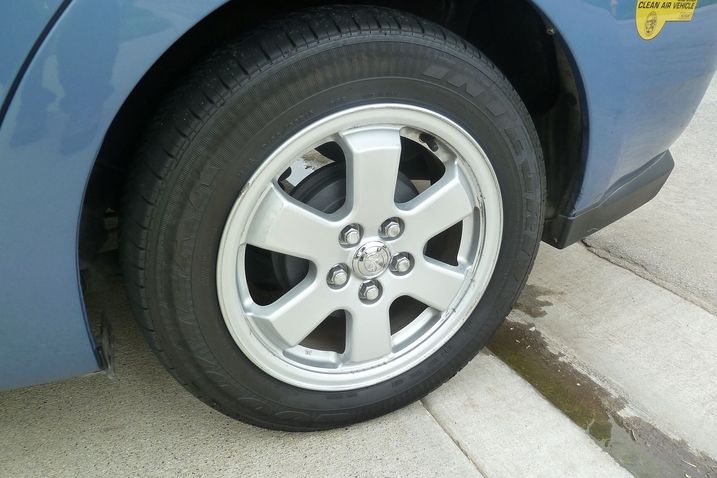
The absent trim reveals a little character out at the end of the spokes. I think the wheels now look a little tougher, the spokes a little longer.
Perhaps the plastic ring was there to provide an aero benefit. If so, our mpg may plummet by 0.001 mpg, maybe more. I'm inclined to face down that woeful risk and remove the other three. Who's with me?
What have we learned? With regard to our 2004 Prius, at least, the less of it there is, the better it looks. ;)
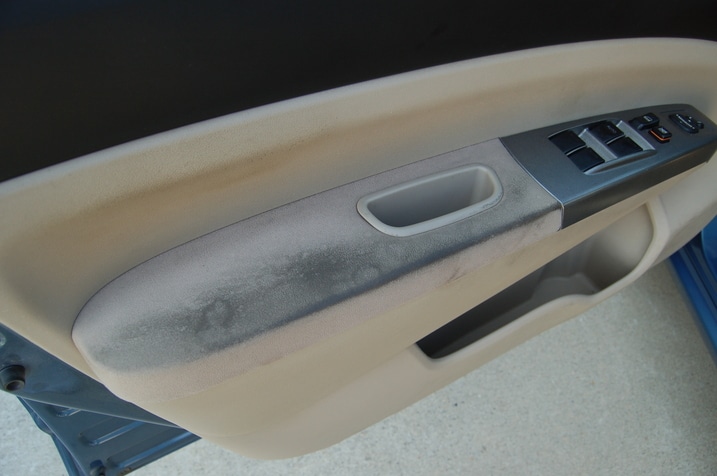
My roommate in college had a denim couch that he absolutely loved, but the rest of us hated. It had a sickening dark sheen to it from plenty of pizza grease, cigarette ash and spilt beer. We nicknamed it "Deal Breaker" because its vile presence would horrify any woman that came to our apartment.
After a few weeks and 10k+ miles in the Mojave, the Prius has become the new "Deal Breaker." The combination of dirt and sunscreen has made the drivers side arm rest akin to that damned couch. When I drove the Prius, I made sure my skin and clothing did not touch the armrest.
I think it's time for a thorough cleaning.

Thanks to sherief for this week's favorite caption.
Here are the others that helped us blow off some steam.
A new train of thought. (ergsum)
The picture of the locomotive has more HP. (old_volvo)
Hey! Jackasses! You're about to get hit by a train! (shladney)
I'd take the donkey. (dougtheeng)
Still life; action shot of a Prius (mnorm1)
See Marty, I told you what would happen if you hit 88 mph (mnorm1)
Doggone it Fido! That's not a hydrant!!! (mrryte)
Better get your ass out of the way! (zoomzoomn)
$3.10 a Gallon to Yuma (ergsum)
I think those are Edgar Rice's burros. (mnorm1)
2004 Prius: Track Tested (ergsum)
How the west coast was won by Toyota. (technetium99)
Hatchback to the Future - Part III (ergsum)
I thought I could, I thought I could, I thought I could... (vt8919)
What was your favorite?
To the winner, you can choose one of these fabulous prizes:
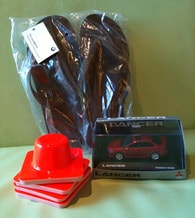
BMW flip-flops
Mitsubishi Lancer model car
set of mini cones
Send your choice and your address to dderosa (at) edmunds.com
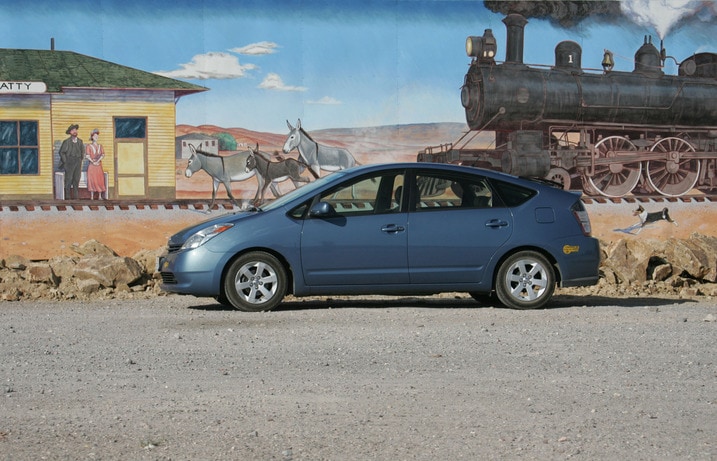
Another gem sent to me by Vehicle Testing Manager Mike Schmidt. This time our Prius is admiring some old-time transportation.
What is your caption?
We'll post our favorite this afternoon. And, yes, there will be exciting prizes.
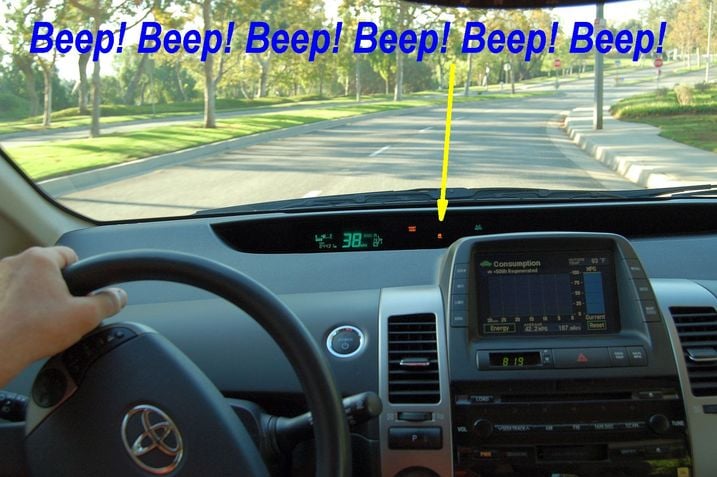
Over the last couple of days our 2004 Toyota Prius has sent out numerous Electronic Skid Control false alarms. Light flash, brakes sometimes grab to "correct" a non-existent slide and, most of all, a piercing piezo beep fills the cabin.
The first time it happened I has sweeping through an on-ramp. Was I going that fast? Not really. Did I hit a bump, or something? Probably. I didn't think much of it.
Next morning, my wife grabbed the keys to take the kids to school, 10 miles distant. She called back in 5 minutes.
"Get the van ready," she said. "I'm bringing this thing back. The skid control is going nuts."
One of the places she said it happened was the road above, not 200 yards from our home. There is nothing in the way of G forces here, just a gentle bend to the right as you coast slightly downhill to the stop sign ahead. It happens every time, exactly where this picture was taken, so long as the speed is 33 mph or higher. The posted limit is 35 mph.
And then I remembered some things that might add up to a theory...

When I first drove the Prius home from the office, I noticed was off to one side — way off. Ten degrees, at least. Could be alignment, could be excess "conicity" in the well-worn tires, could be lots of things.
Here's another piece of information: the ESC false alarms only occur when turning right. I proved that to myself with some lane change maneuvers on a deserted road. There are no problems turning left.
Here's how these two facts add up to an early ESC warning. Let's say my local bend in the road requires 70 degrees of steering input. The ESC computer actually measures this using a steering angle sensor deep in the steering column. It compares the measured steering angle to the cornering G measured in another sensor to calculate the degree of understeer or oversteer.
But if the wheel is at minus 10 when I'm going strainght, my 70-degree right input will measure only 60 degrees on the steering angle sensor. The computer could be comparing this to the lateral G being produced and say to itself "That's not enough steering input for this amount of lateral G. The car must be oversteering. I'd better DO something."
Beep! Beep! Beep! Beep! <brake grab> Beep! Beep! Beep!
Now, you're probably think about left turns of the same magnitude. The computer would see 80 degrees, and think this was more understeer than usual. Well, oversteer is the more heinous situation, (to an ESC computer, at least). It will be much more sensitive to oversteer.
Beyond that, I'd like to think such systems would be smart enough to "learn" where straight ahead is and compensate for worn tires or bad wheel alignment. Maybe some do and some don't. The technology was still in its infancy when this particular car was originally in development.
For grins, I looked underneath for any signs of damage. Was there a rock strike? Is something bent. Nope. Everything looks just fine under there.
Damage can't explain it. The steering wheel is off center for some other reason. Here's my plan:
First: I'm going to install new tires. One of them is bad anyway, but it's a rear, and rear tires don't cause pull or steering wheel misalignments. Besides, the front ones are worn, too, and worn oddly. There could be excess conicity at work, enough to create sufficient right-hand force to make me have to steer left to go straight.
If these were good tires, I'd simply swap the front tires left-to-right to redistribute the conicity so it acts in the opposite direction. If conicty was the culprit, I'd see a change at the steering wheel. But since these tires are worn, I'm going straight to new ones.
Second: If the steering wheel is still "off" to one side after the new tires, I'll adjust the toe-in at the tie rod ends to recenter the steering wheel.
Third: There is no third. If these two steps don't work, my theory is wrong and I'll have to take this Prius to the dealer.
But I think I'm right. We'll all soon see after I get back from the tire store.
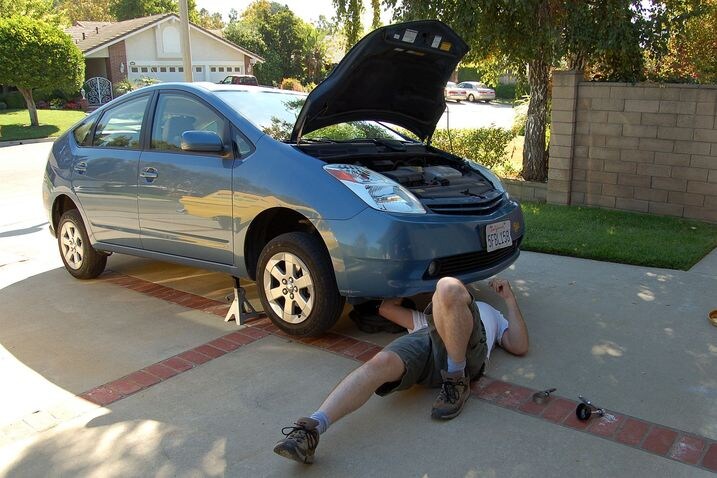
The weather in Yorba Linda was smoking hot this weekend. If I was going to change the oil and filter on our 2004 Toyota Prius, it was in my best interest to get it done quickly, before the sun got too high in the sky.
That was OK by me. I've never actually timed myself. I'm usually too busy taking pictures or video along the way to be truly fast. How long does it take me to do a basic oil and filter change when I'm not trying to film it?
Here are the rules: 1) I'd follow the same steps outlined in my last Prius oil change video, but I'd reset the "Maint Reqd" light after time stopped so I could go inside and wash my hands thoroughly before touching too much of the interior. 2) Before time started, I could lay out all the needed tools in one spot about 5 or 6 feet from the car, but I could not pre-stage them in the exact spot they'd be needed. 3) I couldn't open the hood or jack the car until after time started. 4) I couldn't stop the clock until after the hood was closed and the car was back on the ground. 5) Tool clean-up, also off the clock, would wait until I had a tall glass of water and changed the oil in my wife's minivan, as well.
These are the rules. Place your bets.

I thought I was going to break 10 minutes, but the end-driven oil filter wrench got hung up and wouldn't come off, the oil went in slower than expected and I fumbled the iPhone timer and lost a couple of seconds trying to stop the clock.
Next time.
Total cost: $21.69 ($19.99 plus tax). They were having an oil and filter special at my local Autozone: 5 quarts of Valvoline and a Fram filter. The Prius only takes 4 quarts, so I've got one left for next time.

Our 2004 Toyota Prius is wearing a brand new set of tires. The last set was badly worn, and the wear had grown uneven, over time. One had been driven on flat (or very low) long enough to score the inner and outer sidewalls. It was time.
The original Goodyear Integrity OE tires never got much love from our cadre of test pilots, so we wanted to try something different. Our choices were many because a lot of companies, Goodyear included, have brought out new "green" second-generation low rolling resistance tires for the Prius, each claiming more grip, shorter wet stopping distances, the same or better ride, the same or better noise and perhaps even a little less rolling resistance than the original rubber.
I was leaning toward the Bridgestone Ecopia, one of those new "green" tires. The final decision became simple because my local Bridgestone dealer, the one next to the Autozone where I dispose of my waste oil, was open this past Saturday, had them in stock and could do it in an hour, right then and there.
Done and done. The Prius had new shoes before I had lunch.
Furthermore, as I'd speculated, the new tires cured the Prius' steering wheel misalignment and ESC problems, single handedly and immediately.

Without so much as touching the suspension, the new Ecopias brought the wheel back to dead center when driving straight. The pull is gone. It's back to square.

Meanwhile, back at the scene of the original crime, the ESC system no longer fires when it's not supposed to. No flashing lights, no piercing piezo screech. It's cured.
I'm not basing that proclamation on just one corner — far from it. Last night, I loaded the family into the Prius for a trip to Trabuco Oaks Steakhouse, some 25 miles distant. And I made sure to take the back way up Santiago Canyon Road, passing Silverado and Modjeska Canyons to Cook's Corner, where we finally turned left onto Live Oak Canyon Road. It's all two-lane, and the route is as scenic — and as twisty, in places — as the place-names suggest.
There were no problems at all. The steering stayed centered, grip was good, the ride was smooth and it may even have been a little quieter than before. Most of all, the ESC system never let out the slightest piezo peep, whether turning left or right.
Moral of the story: If you're having problems that seem to be alignment-related, have a look at your tires before you do anything else. If they're worn down to the point where replacement is imminent, go ahead and get new ones and see how things change before you decide to run off to the alignment shop. You might find that your problem disappears, like ours did. This is more likely in the case of many strut-based cars like our Prius, which has no alignment adjustments except for front toe-in. Without a healthy curb strike or accident to bend something, things can't go very far out of spec.
Tire conicity, on the other hand, can develop over time for a number of reasons. Conical tires, in amounts too small to see, can cause the steering to pull to one side if the concity isn't balanced (equal and opposite) across the left and right sides of the front axle. If you don't want to re-zero everything with new tires just yet, you can check for this yourself by swapping the front tires left-to-right. If conicity is the culprit, your steering pull should switch to the opposite direction. It may even disappear for reasons that get complicated enough for a full-length article.
This is not intended to devalue wheel alignments — they can be very important, especially on cars like the first-gen Miata, which have double eccentric cams on their lower control arms, front and rear. Because they are so adjustable, they can move about more easily, too. Still, unless you know your problem is a direct result of hitting something, have a go at the tires first, then have it aligned if there's still any doubt.
As for the Ecopias, we'll see if we can take them out to the track once they've got a few more miles on them.

I try not to double-up on same-car posts in one day, but I had to share this picture of the outside temperature gauge in our 2004 Toyota Prius.
It ain't kidding. Rght now, here in Yorba Linda, California, 16 miles inland from the Pacific, it is 106 degrees F outside. The weather service is predicting a high of 108 degrees.
At least the electrically-driven AC compressor starts off strong and begins pumping cold air almost immediately after I press the "Power" button to start the car.

OK, we've had our 2004 Toyota Prius for the longest that we've had any long-term vehicle. It's almost at 85K! So at this point, as I browse past blog posts (some so old they don't even have pictures anymore) I can't help but wonder just what hasn't already been blogged about on this car.
I figure I'd ask you guys. I think I already know the answer to this but is there anything you'd like to know about it? Anything? Anything at all? Ask away.
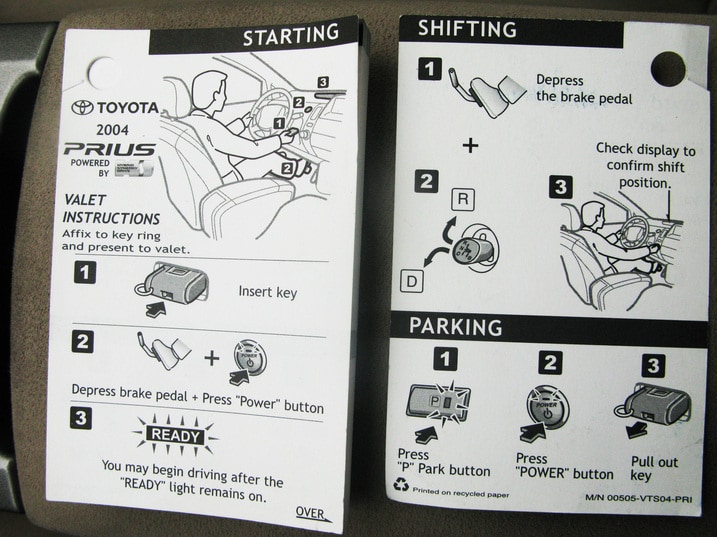
Opening the center console of our 2004 Toyota Prius was like opening up a time capsule. Check it out, valet instructions. Apparently back in the day, the Prius' unconventional gearshifter was too weird to comprehend? In any case, these nifty cards, which come in a stack and have a hole in the top corner so you can attach it to your keys when you leave them with the valet, outline how to start, shift and park the car.
Searching Prius forums, it sounds like the cards were discontinued around 2005-2006. So here it is for those of you who bought a Prius that didn't come with them. Print them out and leave them for the valet or car wash attendants you're not sure of.
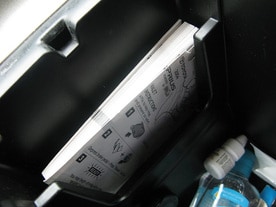
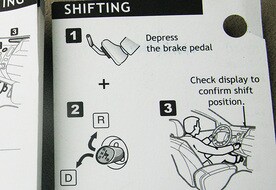

In the previous Open Thread post for our 2004 Toyota Prius, commenter liquoredonlife asked what was the worst MPG it has ever gotten. We've just posted last month's fuel economy of our long-term test cars so you saw that the worst for the Prius was, gasp!, 18.5. But I was curious about how many times during its six years with us we've gotten its mpg below 20.
Turns out that 18.5 was a miscalculation that arose from a previous "short-fill" situation. Once we threw that one out, the correct value for lowest mpg ever is 26.7.
Head for the jump to see a breakdown of our Prius' fuel economy history ever since it first arrived in our fleet.
| 0-10000 | |
| miles | 9989 |
| gallons | 238.32 |
| avg | 41.92 |
| min | 28.14 |
| max | 57.57 |
| |
|
| 10000-20000 | |
| miles | 9965.3 |
| gallons | 242.52 |
| avg | 41.09 |
| min | 28.26 |
| max | 59.27 |
| |
|
| 20000-30000 | |
| miles | 9859.5 |
| gallons | 243.08 |
| avg | 40.56 |
| min | 28.71 |
| max | 52.44 |
| |
|
| 30000-40000 | |
| miles | 9995.4 |
| gallons | 236.53 |
| avg | 42.26 |
| min | 28.26 |
| max | 59.27 |
| |
|
| 40000-54000 | |
| miles | 9961 |
| gallons | 254.18 |
| avg | 39.19 |
| min | 26.73 |
| max | 51.32 |
| |
|
| 54000-64000 | |
| miles | 9826.1 |
| gallons | 241.21 |
| avg | 40.74 |
| min | 30.20 |
| max | 49.85 |
| |
|
| 64000-79000 | |
| miles | 9947 |
| gallons | 256.99 |
| avg | 38.70 |
| min | 28.62 |
| max | 50.12 |
| |
|
| 79000-85000 | |
| miles | 5130.4 |
| gallons | 133.13 |
| avg | 38.54 |
| min | 33.79 |
| max | 50.83 |
The last time we had that high 59.3 mpg was back in October 2004. And we haven't really gotten that close to that number since. Second best mpg was 54.8 that same month.

It's been awhile since I've driven our mega-mile Prius and it's everything I remembered. There's absolutely no steering feel. The ride is unrefined and the power is meager. In other words, it's about as far from a driver's car as modern vehicles get.
Knowing that, I'm not surprised that some Prius owners found their cars speeding beyond their control. They probably never really had control to begin with, they were just riding along.
Still, when I think back to the poor sap who said his Prius was "speeding down the freeway and he couldn't stop it" I just have to laugh. The Prius is so gutless it's hard to fathom the idea of it ever "getting out of control." The brakes are not great, but they are infinitely more powerful that the gas engine, the electric motor or any combination of the two. The idea that pushing on the brakes could not possibly overcome their propulsive force is just laughable.
Thankfully, the hysteria has died down and the incidents have seemingly vanished. Trust me, though, I wasn't the least bit worried from behind the wheel.

How do you jumpstart a 2004 Toyota Prius? It's actually easier than one would think despite the intimidating hybrid technology under the hood.
Yes, last night our Prius was completely dead. Maybe someone left the interior light on all weekend. No one knows. In any case it needed a jumpstart.
By the way, FYI, when a Prius is completely dead, the gears don't work so you can't shift it into Neutral if you have to move it anywhere. Fortunately, our dead Prius was accessible.

So, lifting the hood, since there isn't the usual battery, where to hook up the cables? Fortunately Vehicle Testing Manager Mike Schmidt knew exactly where. Lift the battery cover and there's a red box with a "+" sign on it. Flip up the box and you'll find a bolt where you attach the red cable to. The black cable should be attached to metal. We clipped it onto a nearby bolt on the car's frame.
Then hook up the other end of the cables to the live car, like usual.
Word of caution: Just make sure to close your Prius doors. Our driver side door was open so as soon as the Prius was brought back to life its alarm went off, unfortunately for Mike whose head was still under its hood. Oops.
Anyway, after this, I drove the Prius around for 45 minutes and it was fine.
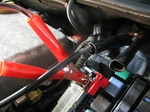
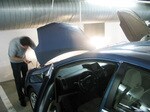


I've always dug the "last 30 minutes" efficiency bar graph display in our 2004 Toyota Prius. However, for the third generation (2010 --), Toyota switched to a smaller, less colorful dash-mounted display (after the jump).
The idea behind the new display, of course, is to keep your eyes pointed closer to the road ahead, rather than on the navigation screen, as you're playing the fuel economy/recharge-the-battery-pack game. I'm sure Toyota's legal team prefers the new display.

But I prefer the old display. And I find that when I drive a third-gen Prius, I'm less interested in playing the game. And if you're driving a hybrid, you need to play the game — that's what you do to make up for the lack of involvement.
So which is it going to be for you — the cool-looking bar-graph display of old or the new, ergonomic, lawyer-friendly, eyes-closer-to-the-road display?

Nice one, Ace. Thanks for being so considerate when parking your shopping cart. Our 2004 Toyota Prius thanks you, too. It was tired of having a smooth door panel. The nice pair of dents you left behind represents a refreshing change. The paint chipped off by your errant cart was an extra added bonus.

The best part is it looks like a pair of snake fangs took a bite out of it. Killer. That's much cooler than the trio of stick-on fender vents it was considering. This is going to be awesome when we try to sell it in the coming weeks. Very endearing.

A lot of people wonder what the deal is with the "B" position on the shifter of the 2004 Toyota Prius (and most other Toyota Hybrids). Some people figure that B increases the level of regenerative braking and plows more juice into the battery.
Not so fast. Turns out the opposite is true.
Compared to coasting in plain-old D, engine speed goes up in B to provide more genuine engine braking. RPMs increase in this mode, just as they would if you had downshifted a regular transmission, with the drag coming from the engine pumping air through itself while the fuel injectors sit dormant. But the Prius planetary transmission's gear ratio regulating element, electric motor-generator MG1, has to expend some battery energy to command the engine's crankshaft speed up to create this extra drag.
It gets worse. Engine braking represents a lost opportunity for the electrical regenerative braking system, the system by which all hybrids collect most (and in some cases all) of the electricity that makes them hybrids in the first place. The mechanical engine pumping losses that are engine braking could and should be avoided so they can go through the regenerative path to the battery instead. But the use of B robs the charging system of this chance and, ultimately, robs your wallet in the form of lost mpg.
In a regular car it would be madness to tell someone they should use the brakes to slow the car when going downhill, but here in the Prius, a so-called "strong" hybrid with sizable electric motors, that's oftentimes better for efficiency and no serious threat to the integrity of your regular friction brakes.
That's because the regenerative braking system in a strong hybrid can develop a significant amount of slowing by using the electric motor as a generator. In the 2010 and 2011 Gen 3 Toyota Prius, for example, the regen system can produce decelerations of up to 0.6g. Our somewhat less-efficient Gen 2 Prius (rated at 46 mpg combined instead of 50 mpg for the Gen 3) doesn't do quite as well in this regard, but the regen braking effect it can produce is still significant.
Need perspective? Most normal stops are made at 0.2 to 0.3g. Impatient folk stop at 0.4g or so. You might touch 0.6g if you get surprised by a yellow light. Unless your license has several points on it, over 90% of your braking occurs below 0.6g.
Unless the grade is very steep or very long, the foot braking mode you'll be in on a downgrade will be an electronic one, with your battery as benefactor. Your brake pads and rotors can't overheat if they're not being asked to do much.
Fun fact: our 2004 Prius has over 85,000 miles on the clock. The original brake pads still have some meat left and the rotors still look good and run true. That's regenerative braking for you.
But you can overdo it. The battery in a Prius can only hold so much, and a long grade can top it fully, at which time the computer begins to rely more heavily on the friction brakes. Keep one eye on your battery monitor and shift into B if there's still grade remaining when the gauge reads full.
Of course fully electric cars have no possibility of engine braking, so this B mode discussion is a moot point. But their batteries and electric motors are so large that they can soak up just about everything the longest grade can throw at them.
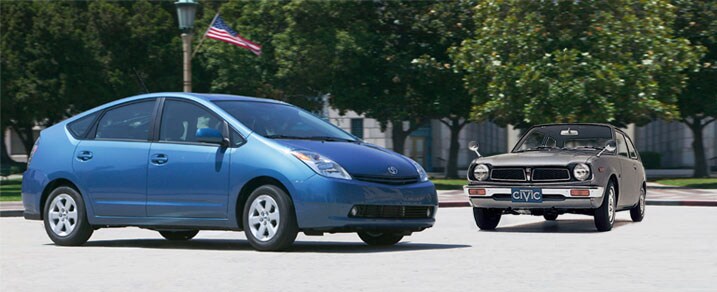
The first Prius I ever drove was a 2004 model. It was just released for sale and was the hot new thing. I was allowed to take it for a weekend out of another long-term test lot and it drew a lot of attention. I'd get stopped in parking lots, barraged by questions like, "what's it like to drive?" and "what's the mileage like?" It was a bit of a novelty back then. Nowadays, it's as commonplace as a cell phones and flat -panel TVs. So now I'm wondering what will be the Prius' legacy?
How will the Prius be remembered? I think it'll go down much like the original Honda Civic and its CVCC engine. It appeared on the scene in the 1970s, when the gas crisis hit and when other manufacturers regarded the new U.S. Clean Air Act as impossible to meet. Sound familiar?
Both the Honda and Toyota showed that smaller and more efficient cars were the way. The Civic unseated the massive Oldsmo-Buicks and other assorted land yachts of the period, while the Prius tempered the SUV movement.
Going forward, I wonder how long the Prius will stay on the road. I can't remember the last time I saw a first-gen Civic on the highway. Will the Prius slowly disappear as battery packs deplete, or will loyal owners keep them out there? Will it simply be a footnote, like MySpace or BetaMax?

At some point in our Prius's history, somebody had the foresight to load our office as "Home" in the now-aged navigation system. A couple interesting things happened when I zoomed in on the POI icon.
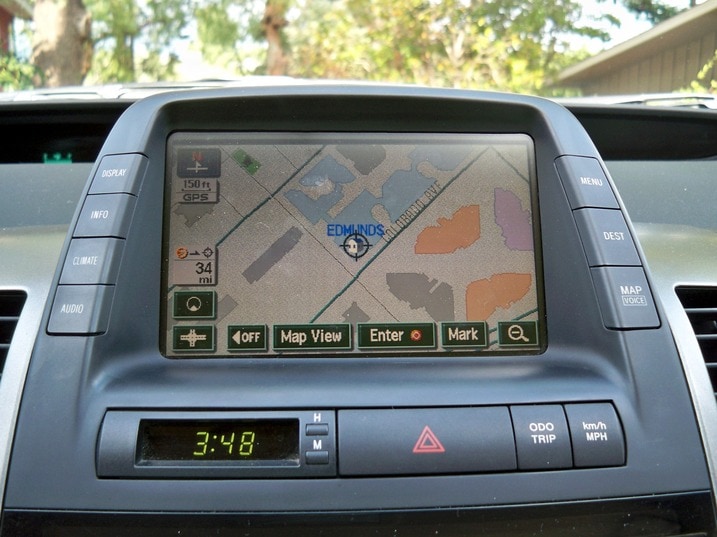
First of all, it's still cool that some navigation systems show building shapes. I zoomed in further to see what else I could see and discovered something else.
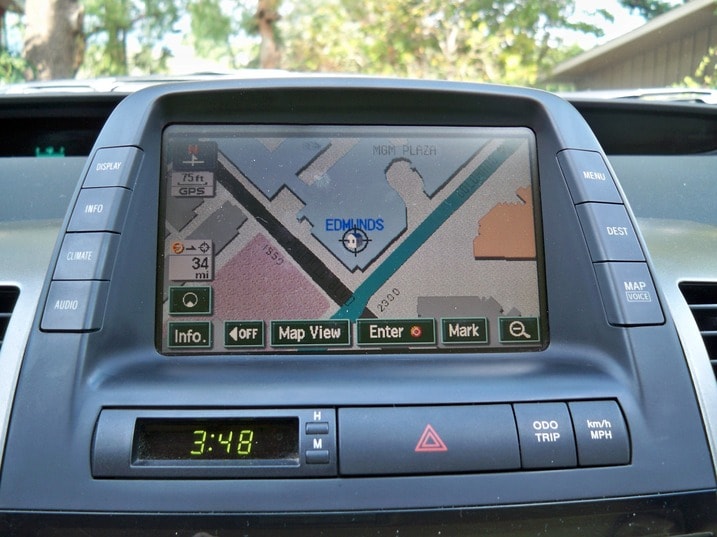
The office complex we call home was once called MGM Plaza. Problem is MGM sold the entire thing in 2001, predating the 2004 Prius by 3 years. I wonder how otherwise out-of-date the navi data is.
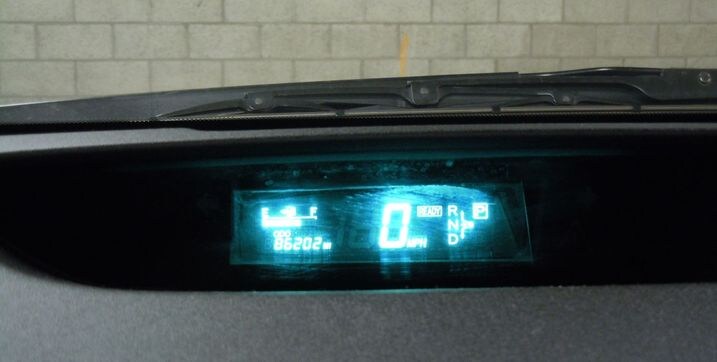
Our long-term(!!) 2004 Toyota Prius has a big digital speedo. Although it's better for elderly people who have trouble reading small fonts with a short focal length, the size and focal length of the speedo is good for everybody. (Yes, the lens of the display appears to have been cleaned with a shop rag or some steel wool.)
The digital speedo is also good for knowing your exact speed. Yeah, I know enthusiasts are supposed to like analog speedos and tachs, so you can see the relative position of the pointer.
But did you know that most modern sportbikes have digital speedos (usually combined with analog tachs)? It's definitely easier to quickly know your exact speed. I really like this setup on motorbikes.
It's not bad on the Prius either.
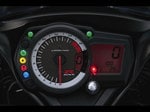

Scott Jacobs wrote a hilarious blog post about how the armrest in the 2004 Toyota Prius reminded him of a couch his college roommate had that they had nicknamed the "deal breaker." If a woman came to visit them, and had to sit on the couch, she would never come back. The armrest of the Prius was like that for me. It was the first thing I saw when I opened the door to get in. Looking at the evil, dark stains I imagined it was emitting the foul odors some editors had remarked on. After months of shrinking from contact with the armrest I snapped into action.
I took the Prius to our local car wash and asked about shampooing the interior. They said it would cost a hundred big ones and take an hour. I didn't have the money or the time so I let them do their usual vacuum and wash. While I was waiting for it to be scrubbed, I browsed the car care products and my eyes fell on a can of foam upholstery shampoo. The advertising said it could be used on "the toughest stains." But it didn't say anything about deal breakers.
On my way back to the office from the car wash I pulled to the curb and hosed the armrest with foam. It was like I was trying to extinguish a flaming jetliner on an airport runway. Foam went everywhere, billowing like cumulonimbus clouds. I scrubbed the arm rest with the brush built into the top of the can. Inky rivulets of grime steamed off the arm rest and down the door panel. I blotted the mess with tissues I found in the backseat. I kept foaming and blotting. The next day, I did it again.
I can't tell you how satisfying it was to have it dry, fluffy and fragrant. I kept looking at the before picture to remind myself of how far it had come. I still think it seems impossible that it could have come back from the dead like that.

I was replacing the front brake pads on the 2004 Toyota Pruis when my son walked by and said, "I'm not good at mechanical things." That set me off. I told him to put on a pair of gloves and help me. Our arrangement was simple: I drank coffee and told him what to do; he did all the bending, lifting and tightening. It was a beautiful relationship.
The brake job was a piece of cake, especially after I read Dan Edmunds' excellent DIY piece about changing the pads on the 2009 Ford Flex. When we got the old pads out I took a picture to show that there was still some life in them. The guy at the Toyota dealership said he had seen some Prius owners doing brakes after 90k miles. The regenerative braking system saves wear on the braking system and this translates to cost savings for the owner.
Here's a not very good shot of the new and old brake pads. The old pad was worn down to within about an eighth of an inch of the pad wear indicator.

We ran into a small problem when the two shims fell off the back of the old brake pads and we couldn't figure out how to put them on the new ones. My son suggested we look at the wear marks from the old pads and line it up that way. Good idea.
Also, the spring clips dropped down so it was hard to slide the pads in on one side. My son asked me what to do now. "Futz with it." He asked what that meant. I said it just means you have to work with it until it slides in the right way and everything fits the way it was supposed to.
Time to do the brake job: 1 hour.
Cost: $64 for OEM brake pads.
Time spent with my son: Priceless.

Our 2004 Toyota Prius has outlasted every other car in our long term fleet. We bought this second-generation Prius six years ago and it has carried various editors over 85,000 miles. But it had gradually lost its luster both in appearance and in novelty. And the time had come to sell it.
When the Prius was first given to me to sell it looked like it had been put through the wringer. Then, Dan Edmunds, director of vehicle testing, put new tires on it which fixed the stability control problem. Still, the interior smelled funky and the arm rest was black with grime. And then one afternoon, I left work a bit late and ventured out into rush hour traffic.
By the time I reached the dreaded 405 Freeway, traffic in the normal lanes was stopped. I fought my way to the carpool lanes and, lo and behold, I rolled along past miles of stopped traffic at about 50 mph. It was like bustin' out of jail. The next day, after scrubbing the grime off the arm rest, dowsing the interior with an odor eliminator and giving the ole Prius a bath, I looked at it with new eyes.
I checked our asking price, which was True Market Value (TMV) average condition level of $8,476. I checked AutoTrader.com to see what other '04 Priuses were going for and they were all over the map. Then, after offering the car to other staff members at that price, I decided to take the plunge and buy it.
I've had the Pruis for about a month now and I have to say I'm enjoying it more than I expected. Previously, I was commuting in a 2007 Honda Fit Sport and while I have to say I think that's a great car for around-town errands, it's not a comfortable car. The Pruis is a bit bigger, quieter, gets better gas mileage and has more features such as steering wheel-mounted temperature and audio controls. The only down side to it is that now I'm viewed as a Pruis guy. For me it's not a political statement, it's the easiest way to get to work and home again in LA without losing your mind.
Imagine It Bigger
There was a time when the Toyota Prius was THE alternative fuel car to have. But now with the Leaf, Volt and many hybrid alternatives to popular models, the Prius is no longer all that, well, special. So Toyota is making it bigger. Apparently the carmaker will unveil the supersized version at the 2011 Detroit Auto Show next month.
The above video is for something called The Prius Project, where Prius fans were invited to Malibu to put a big puzzle together showing the current Prius in front of the larger 2012 model.
I don't know about you but I'm thinking a Prius minivan is a natural fit.

Ever wonder what happens to the long term test cars after the editors are finished with them? This is your lucky chance to hear from the old 2004 Toyota Prius after leaving the fleet last Fall. That's because it was purchased by yours truly, Philip Reed, senior consumer advice editor.
I bought the Prius two months ago and I've already put 2,000 miles on it. It successfully survived the torrential rains of last week's historic storms. For Christmas the Prius received a new set of factory beige floor mats which brighten the interior greatly. I'm also happy to report that I've only discovered one defect.
Some mornings when I come out the brake lights are on. Yes, just the brake lights. Dan Edmunds, director of vehicle testing, suggested it was a faulty brake light switch under the brake pedal. I jammed a shoe under there one night and, sure enough, no morning brake light. I'm going to get it fixed as soon as I get around to addressing a recall I received for the pump that cools the hybrid system. Until then, I keep a strap in the car and attach the brake pedal to the steer wheel at night.
With access to the car pool lanes and gas prices climbing to $3.25 a gallon in California, I'm really glad I bought the Prius. After driving 385 miles, I rare put in more than eight gallons. While despised by car enthusiasts for its light steering and floaty suspension, it remains the easiest way to get from home to work and back easily, quickly and cheaply. For me, that's a priority right now.

This will be read with sympathy by some and detacted amusement by others. I've been kicked out of the carpool lanes. I'm back to the real world which, in Los Angeles, means being stuck in traffic, slogging along in stop and go (mainly stopped) traffic. I'm once again one of thousands, sitting in a little box staring at other stopped boxes stretching off into the distance.
Last night was my final commute in the carpool lanes and, wouldn't you know it, traffic was horrible in regular lanes and just fine thank you in the carpool lanes. When you're going 45 mph past miles of stopped traffic, it feels like you are traveling at the speed of light. It feels like you just busted out of jail.
The whole idea behind riding solo in the carpool lane was to incentivize the purchase of hybrids to save the environment. But they've upped the stakes now — the only way to get into the carpool lanes is to have an all-electric or natural gas car. The incentive worked on me. I'm getting a 2011 Nissan Leaf, hopefully in July.
I bought our long term Prius back last October because it had new tires and carpool stickers. At that time I felt July would never come. But it is here and now and all I have to look forward to is the delivery of my Leaf and the carpool stickers it will eventually bring. Meanwhile, all I can say is, it's been a good run.
For anyone still interested in this 2004 Prius, it's been a great car in every way. I've put 8,161 miles on it and only had one issue. The brake lights came on when the car was parked over night. Toyota did the repair for free since it was part of an ancient recall. It now has 94,578 miles and all I can complain about is that the car has a generally loose feeling to it. But on the last tank of gas I got 49.4 mpg and at $3.99 a gallon that is some consolation for losing carpool lane rights.
Wrap-Up
Toyota Prius. We all know the story. This was the hybrid that changed the way we look at hybrids. While the original Honda Insight holds the honor of being the first U.S.-sold hybrid, the Toyota Prius was the first offered to consumers (in Japan). But the second-generation Prius holds another distinction. It's the hybrid that made the largest impact on the automotive community and it became the poster child for the "Hey, look at me; I'm green" crowd.
Which, as it turned out, is a sizable crowd. When the updated 2004 Toyota Prius hit the market, it brought the masses. Look in your neighbor's driveway. There's a Prius. Now glance at the car in the lane beside you. There's another Prius. They're everywhere. Heck, Tom Hanks has one. So does Cameron Diaz.
Well, we weren't about to stand idle as the world passed us by. Before our local Toyota dealership even stocked the new version of its hybrid sensation we were shopping for one. It wasn't long before we purchased a Seaside Blue Pearl second-gen Prius for our long-term test fleet.
Why We Bought It
We have to turn back the clock several years to unlock our reasons for buying the Prius. For 2004 Toyota completely redesigned its first-generation hybrid. Season two added Hybrid Synergy Drive, a full hybrid system with a more powerful 1.5-liter gas engine producing 76 horsepower and 82 pound-feet of torque. Gasoline power was backed by an electric motor generating 67 hp and 295 lb-ft of its own. Efficiency improvements earned the new Prius a bevy of marketing acronyms. It was a SULEV (super ultralow-emissions vehicle). It was a PZEV (partial zero-emissions vehicle). And it was environmentally BA (badass).
Toyota groomed the Prius to be king. When the 2004 model arrived, its popularity soared well above other existing hybrids like the Insight and Civic Hybrid. We'd like to say we predicted the Prius would become the Slug-Bug of the new millennium, and that's why we bought it. But our test began merely as an assessment of its emerging new technology. Nearly 400 new patents were issued for the 2004 Toyota Prius. This was a significant vehicle. Its hatchback versatility and top-ranking fuel economy made it a consumer must-have and secured the Prius an extended stay in our long-term test program.
Our early Prius questions remained. Are the HOV-access stickers worth the money? Would fuel economy decline as the batteries aged? How long until the batteries failed and how much would it cost to replace them? But as our Prius test grew in length, it also evolved. Why we bought it became more of a question as to why we kept it. And six years later we were finally ready to part with our benchmark, second-gen Prius.
Drive and Durability
There was a general consensus when it came to how the Prius drove. Senior Editor Erin Riches echoed our sentiment, "Ride quality is not a strength of the Prius. The suspension keeps the ride reasonably smooth on the highway, but it's about as forgiving as my mom's '93 Accord — tolerable by today's standards but not ideal. There's also quite a bit of road noise. Besides that, the driver seat gets uncomfortable on long hauls. The biggest problem is the minimal number of adjustments. The steering wheel is mounted close to the dash and it doesn't telescope. On a positive note, the second-gen Prius is acceptably quick for a hybrid. During one trip I drafted off the trucks on Highway 46 while waiting for an opportunity to pass. Full throttle was essential for passing but it was hardly a white-knuckle event."
Inside the cabin our Prius boasted an early-generation touchscreen media interface and a cassette player. It was bare-bones by today's standards. Even its cloth Ivory interior left something to be desired. Senior Photographer Scott Jacobs reflected on the last night he spent in the Prius. "My roommate in college had a denim couch that he absolutely loved, but the rest of us hated. It had a sickening dark sheen from pizza grease, cigarette ash and spilt beer. We nicknamed it 'Deal Breaker' because its vile presence would horrify any woman who came to our apartment. The Prius has become the new 'Deal Breaker.' The combination of dirt and sunscreen has made the driver side armrest akin to that damned couch. When I drove the Prius last night, I made sure my skin and clothing did not touch the armrest."
Our Prius was not without its problems. We averaged about $135 per visit for routine maintenance as recommended by the owner's manual. This average included a couple of $22 do-it-yourself oil changes. Other repairs were minimal. We replaced the brake pads ourselves at 86,000 miles for $64. New tires at 84,000 miles remedied a stability control warning issue. Mounted and balanced, these new Bridgestone Ecopias set us back $460 and performed equally as well as the OE Goodyear Integrity tires. Extreme curb rash enticed us to buy a new front wheel cover, which cost $380 and concluded routine out-of-pocket expenses.
Aside from the routine we had some notable non-warranty items during our test. One came in the form of an electrical short in the navigation unit. Another resulted from simultaneous failures of the air-conditioning compressor and inverter pump at the 71,000-mile mark. This was expensive and took days to fix, but Toyota recently began accepting refund applications for the inverter pump issue as part of a "customer satisfaction campaign." At the time of this wrap-up we've submitted our application and hope for a full repayment.
Total Body Repair Costs: $690
Total Routine Maintenance Costs (over 72 months): $2,160
Additional Maintenance Costs: $3,957
Warranty Repairs: Recalibrate faulty fuel gauge, replace faulty fuel gauge, brake light switch recall and replace the steering shaft per recall.
Non-Warranty Repairs: Replace navigation unit ($604), air-conditioning compressor ($1,709), inverter pump ($700), wheel cover assembly ($380), key fob battery ($40), brake pads ($64) and tires ($460).
Scheduled Dealer Visits: 16
Unscheduled Dealer Visits: 4
Days Out of Service: 12
Breakdowns Stranding Driver: None
Performance and Fuel Economy
One thing was clear after 84,000 miles of testing the Prius. Performance is not an area where this vehicle was meant to excel. But we knew that going into the test.
Give the Prius a quarter-mile of asphalt and the hybrid will dispatch with it in 17.7 seconds at 78.0 mph. It needs 10.2 of those seconds (with 1 foot of rollout) to reach the 60-mph mark. And from 60 mph the Prius returns to a stop in 124 feet. Each of these tests ranks the Prius as average among the hybrid populace. Its slalom speed of 59.8 mph and 0.72g of lateral force around the skid pad are similarly bland.
Where performance ends, fuel economy begins. We averaged 40.9 mpg during our test. Admittedly, much of that mileage was accumulated with little concern as to our overall fuel efficiency. That didn't mean the Prius couldn't perform when asked. We found that even toward the end of our test the Toyota could attain 50-plus mpg with little effort.
Best Fuel Economy: 63.5 mpg
Worst Fuel Economy: 26.7 mpg
Average Fuel Economy: 40.9 mpg
Retained Value
When we purchased our Prius, there wasn't a dealership in town that would sell one without a markup. So we went to another town. We didn't need to go far before locating a dealership willing to sell at MSRP. We paid $26,053 to the Internet sales director at Carson Toyota for a Seaside Blue Pearl Prius with Ivory interior.
Six years later it was time to sell. After 84,000 miles Edmunds' TMV® Calculator valued the hybrid at $8,476 based on a private-party sale. This equaled 67 percent depreciation, a valuation directly reflective of its length of service. Senior Consumer Advice Editor Phil Reed then took the keys, as he usually does when we sell long-term testers. This time was different, however.
Reed discussed the process. "I was preparing to put the Prius up for sale, so I drove it home one Thursday afternoon. I left the office a little late and when I hit the 405 freeway it was locked up solid with traffic. I swung into the carpool lanes and cruised along at 50 mph past miles of stopped traffic. The next morning I woke up and decided to buy it myself. I've really been enjoying driving it — it's the perfect commuter car."
True Market Value at service end: $8,476
What it sold for: $8,476
Depreciation: $17,577 or 67% of original paid price
Final Odometer Reading: 84,033
Summing Up
Our test of the Prius began just like any other long-term test. We bought the car to drive around for a year and reflect on its emerging technology. As time passed, the focus of our test changed.
Toyota built this hybrid to stand out among its peers. It set the benchmark for 2004 and beyond. During our extended test we watched the popularity of the Prius soar. Buy it for status. Buy it to save the environment. Buy it for the HOV stickers. It didn't matter why, but people were buying the Prius and doing so in droves. All the while automakers did their best to copy the mold cast by the second-gen Prius.
Today much of the same excitement surrounds the Toyota. This is easily among the most significant vehicles of the past decade. It arguably sits atop that list. When judging its popularity we need look no further than our own ranks. We drove a 2004 Toyota Prius for six years and racked up some 84,000 miles. Then we sold the car, to ourselves. We can't give the Prius much more of an endorsement than our own, hard-earned cash.
Edmunds purchased this vehicle for the purposes of evaluation.
